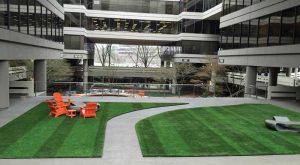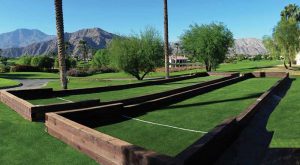
Synthetic grass appears in commercial landscape applications everywhere, from common areas to sprawling lawns, in every venue you can imagine, be it a hotel, business complex, municipality, event space, sporting field, shopping plaza, or apartment complex. It is a frequently used solution for contractors and specifiers who want a landscape that is able to stand up to high-traffic demand, offer enhanced drainage capacity, stay green all year, and require little to no maintenance.
The return on investment (ROI) benefits are also an incentive and include lower water bills; reduced landscaping costs, as there is never a need to mow, resod, or fertilize synthetic grass lawns; and possibly even reduced janitorial costs associated with mud being tracked into facilities. Further, synthetic sod is weatherproof, meaning everyone can enjoy a lawn which stays green year-long regardless of the season. Whether they are used for common areas of an outdoor shopping mall, on the rooftop patio of a commercial office building, or in between pavers to enhance the aesthetics of a hotel, synthetic grass systems provide solutions, and their design and installation are key to project success.
Watering bans and other restrictions
Drought concerns have caused states like Nevada to ban the installation of natural grass in certain applications in favor of drought-resistant landscaping, while California will no longer sell gas lawn mowers or leaf blowers by 2022 as part of the state’s clean energy campaign and pledge to the environment. As new bans and restrictions arise, synthetic grass becomes even more appealing, as it eradicates the need for watering the lawn and offers one-step, 100 percent recyclability, meaning one will never find it in a landfill. This is different than other turf products, which can only be partially recycled due to their urethane backing. Synthetic sod is also low maintenance when it comes to landscaping. Since it does not need to be mowed, lawnmower emissions and noise pollution are eliminated.
Synthetic grass lifecycle and maintenance
The high-traffic yarns of synthetic grass produce resilient surfacing to provide years of low maintenance. The biggest threat to synthetic grass yarn is the sun’s ultraviolet (UV) rays, which break down the yarn and disintegrate the fibers, causing them to get shorter over time. During the yarn extrusion process, plastic pellets are melted down into a liquid and UV-resistant stabilizers are introduced. This additive has a 20-year lifecycle and most additive producers offer a UV protection warranty for 10 years.

So, with an additive which lasts for 20 years and comes guaranteed for 10, how long does synthetic grass last? The real answer has to do with gravity. This fundamental force will eventually affect everything, and synthetic grass fibers are no exception. While specialized yarn is engineered to fight gravity, it is not eternal. Most synthetic grass fields, lawns, and pet yards are made of polyethylene due to its memory properties. Just like the carpet found in most homes, which reacts with indentation after one moves a piece of furniture, these polyethylene fibers have memory and will stand up after heavy use. Eventually, though, with traffic and time, gravity wins, and the surface fibers remain bent. At this point, there is nothing wrong with the performance from a running, playing, drainage, or usage standpoint. The synthetic grass installation simply no longer looks new. One can make use of a rotary broom to brush the sod and alleviate the look of aging fibers. The earlier and more frequent this brushing maintenance occurs the better. Monthly or even quarterly brushing can help prolong the desired aesthetic, and specifiers ought to note this recommendation in their specifications.
How to install synthetic grass
The synthetic sod installation process starts with builders compacting the sub grade (usually dirt), installing a road base layer for stability and then—within this road base layer—embedding drainage to quickly remove surface water, primarily from rain. Builders then install padding if necessary, and finally, they roll out the turf and install an infill of sand or another product to help hold the turf down and keep the fibers erect. While this sounds simple, there are several things to consider.
Drainage, cushioning, and heat
Synthetic sod is a popular choice for sports fields and its design and installation at colleges, universities, high schools, public playing fields, and the like, is an important consideration. Once a specifier has identified a suitable fiber from a traffic and aesthetics standpoint, drainage, cushioning, and heat needs to be addressed.




